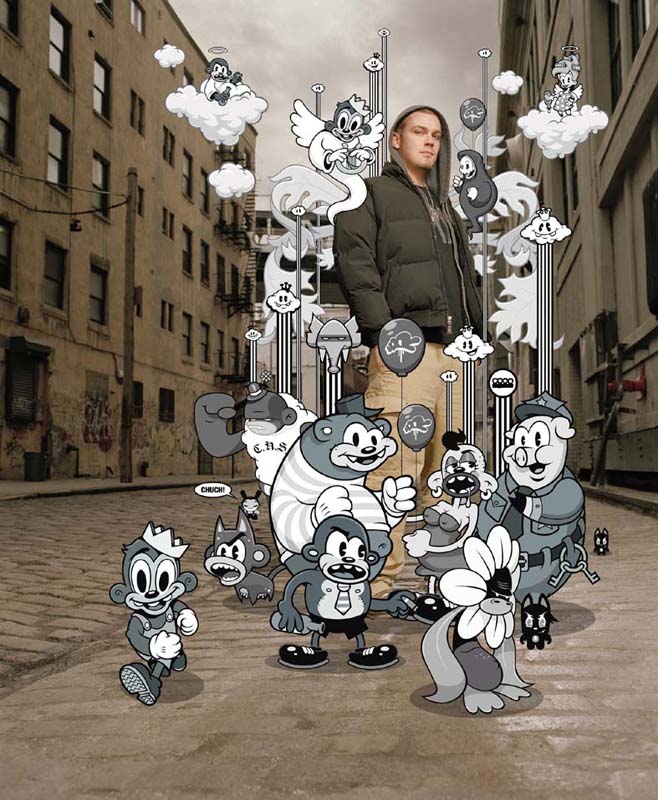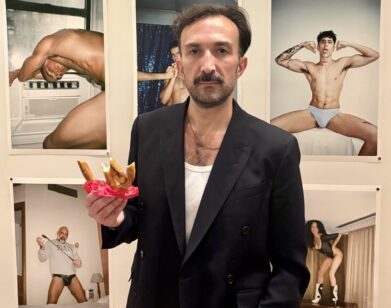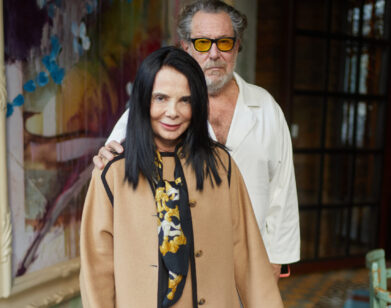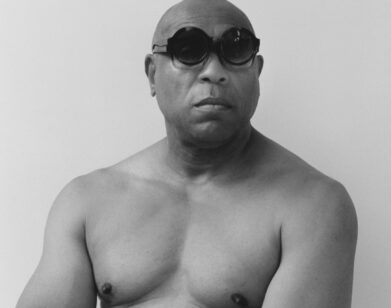Tristan Eaton in the Third Dimension

IMAGE COURTESY OF TRISTAN EATON
3D isn’t just for action-packed Hollywood anymore. Tristan Eaton’s The 3D Art Book (Prestel) takes us to a quirky, retro world of three-dimensional fine art pieces, viewed through old-school red-and-blue shades. The handsome volume was four years in the making and draws on Eaton’s curatorial experience at Kid Robot and his own Brooklyn creative collective, Thunderdog Studios, to bring together eye-popping works from Shepard Fairey to Ron English and Mishka NYC. With an introductory essay by Carlo McCormick, The 3D Art Book is both cultural commentary and a mind warp of a conversation piece.
ROYAL YOUNG: How did you choose the artists in the book?
TRISTAN EATON: Over the years, I’ve gotten to know so many artists, just through being an artist myself and creating projects that involve artists, like curating for Kid Robot toys, or curating artists to work on projects for my company Thunderdog. The first guideline was, whose work would look kick-ass in 3D, and who do I know, who can I reach out to whose work would be great for the book? So I kind of started with my inner circle, then I had a wish list.
YOUNG: How many people from the wish list actually ended up in the book?
EATON: A lot of people. Like, I know Shepard Fairey, but he’s the kind of guy you rarely want to ask favors from, because you imagine one day down the road, there could be one big favor you want to ask him for.
YOUNG: You’re kind of saving up for that one.
EATON: Yeah, but this was it, I guess. So I emailed him and he agreed immediately, which was cool.
YOUNG: How did you choose pieces that were going to pop the best once those 3D glasses were on?
EATON: Well, I think the first perspective you have to have is from a technical standpoint. Can we break up the art into layers? There are some images that have fades and halftones that can’t be pulled off their backgrounds, unless they gave us a layered file. So, the majority of the artists would give us flattened Photoshop files or photos of canvases, and we would have to literally cut it into a hundred different pieces.
YOUNG: You’re carving out the 3D from it?
EATON: Exactly. We had to cut every single object onto its own layer. So that was a pretty big thing to keep in mind when we chose what art, because you could be sitting there for three days on one piece, if you’re not careful. Out of the hundred pieces in the book, we did 3D internally for 95 of them.
YOUNG: Is that something you had worked with before?
EATON: Yeah, I’ve been doing 3D for my personal art for a long time and did an exhibition at the now-closed Soma Gallery, which was run by Bucky from Animal New York, which is like a New York blog now that’s pretty popular. And back then, he gave me this little solo show of 3D art, and I started doing collaborations with other artists, where I would email someone a file and they would add to it and then I’d add to it again and send it back, and once we finished our collaboration, I turned that into 3D. I did that with The London Police, Jeff Soto, and showed those in the exhibition, and people loved it. The event itself was so wild and crazy: a whole room full of people with 3D glasses on was hilarious. The electricity of it was awesome, everyone pulling each other over to point things out. There was a really live engagement with the work and that planted the seed for the book, later on. Because it was the first time I was not only doing my own art in 3D, but getting other artists to do their work in 3D.
YOUNG: So it was part of a larger conversation?
EATON: Yeah, totally. When we create art, a lot of times we’re creating the illusion of 3D, by creating volume, shadow and light. For a lot of the artists to see that distance realized was really cool for them, it was seeing their own work in a new light.
YOUNG: How did you initially become interested in 3D? Was it the show we were just talking about? It seems like it was deeper than that, earlier than that.
EATON: Yeah, it was earlier than that. I think for me, it was just a strange, bizarre, retro gimmick that I was really fascinated with. I’d seen it in comic books, and on TV from time to time in the early ’80s. When they showed old King Kong films on TV, you’d have to run to the 7-11 to get the glasses to watch it, and that kind of nostalgia was cool for me. I tried it out for the first time when I was about 19. I worked at a rock poster silkscreen shop in Detroit back then, and I would print all these big artist’s posters. Then every once in awhile they’d let me print my own posters, and of course, I’d take advantage of that fully. I had them break out the largest printing press they had, which printed five feet by seven feet, and tried to do a 3D silkscreen print. I’d never done 3D before in my life, so I was in way over my head, and I produced like 20 prints of this giant 3D silkscreen and it failed horribly and the 3D didn’t work at all, but it looked so cool, just without the glasses, even. And I think that’s been another attraction to that style is the 3D art without the glasses, especially with line art. Red and blue line art overlapping and creating black, and just that alone is really beautiful to me.
YOUNG: I feel like such an asshole asking this question, but what do you think about Avatar and this kind of resurgence of 3D movies?
EATON: [laughs] Well, I think it’s cool that it’s coming back around. The technology has evolved to the point where it’s flawless.
YOUNG: Right. I feel like it’s a different kind of 3D.
EATON: It is, because the glasses are clear and they don’t give you a headache after five minutes. Over the last five, six years, 3D has kind of become the norm in cinema, especially in kids’ movies, which is great. And I think that didn’t really have any bearing on why we did this book, but it’s a good coincidence that it’s becoming a bigger part of the social consciousness now, and even more important to have an art project that shows there are more retro routes, when the 3D was a little quirkier and analog.
YOUNG: Yeah, and I feel like it engages the viewer in a completely different way.
EATON: You’re absolutely right, and that’s why the book comes with two pairs of glasses, because you’re going to want to look at it with someone—and I pushed for that, because it’s definitely a social experience to look at 3D art.
YOUNG: Where do you see 3D in the future?
EATON: I’m not going to be happy until people have chess sets like Star Wars. That’s where it gets really good.
THE 3D ART BOOK IS AVAILABLE NOW.






